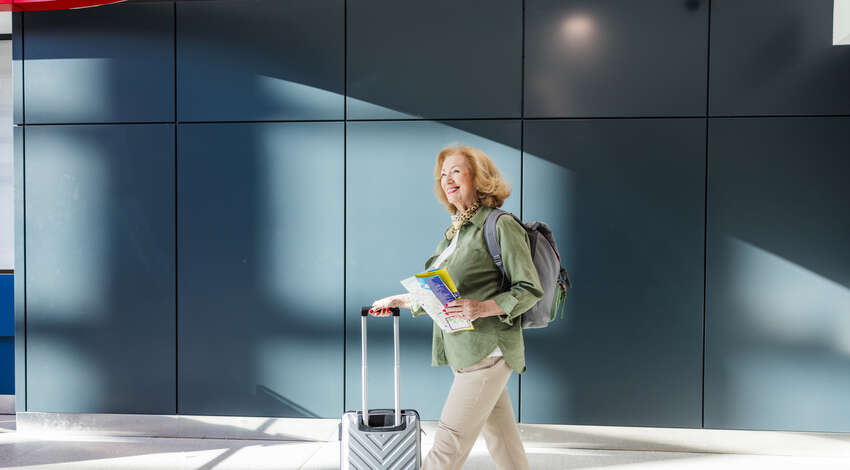The Ultimate Airport Guide: Tips, Amenities and What to Expect
- Arrive early and check in online when possible to save time at the airport and avoid long lines at kiosks and check-in desks.
- Pack smart by following airline and security regulations, and know which items are restricted to avoid delays at screening.
- Take advantage of airport amenities like lounges, shops and wellness zones.
- Use travel apps to track your flight and gate changes, manage time and reduce stress.
- Stay rested, hydrated and informed for a smoother travel experience that makes your adventure more memorable.

Airports are gateways to every great journey, but they can also be a great source of stress if you’re not prepared. In this comprehensive airport guide, we offer the airport travel tips you need for a smooth and easygoing journey, whether you’re a frequent flyer or an occasional traveler. Between check-in and takeoff, these airport tips cover everything from navigating security to finding the best airport amenities to stay comfortable during layovers and managing flight delays. Let this complete airport guide turn your time at the airport into a positive part of your adventure rather than a hassle.
What Should You Do Before Heading to the Airport?
Before heading to the airport, preparation is key for a seamless travel experience. Let’s explore what you should do to set yourself up for a successful journey. One of the key pieces of airport travel advice is knowing what to do before you set foot in your terminal. Prior to leaving home, confirm your flight status, check traffic or public transportation times and make sure your airport travel identification, such as your passport or driver’s license (Real ID), tickets and travel documents are ready. Have your bags packed, boarding passes downloaded or printed out, and all liquids and electronics organized for security screening. A little preparation helps avoid last-minute stress.
How early should you arrive at the airport for your flight?
In any airport travel guide, you’ll find that the recommended time to arrive for domestic flights is at least two hours before departure. For international flights, plan for at least three hours. This gives you plenty of time to check your bags, clear security and handle any unexpected delays without rushing.
What should you check before your flight?
One of the most important airport travel tips is to always double-check your flight time, gate number and terminal before heading out. It’s also wise to review baggage policies, security requirements and airline updates to avoid surprises. If you’re traveling internationally, confirm the visa or entry requirements for your destination, too.
How do you pack smart for air travel?
One of the top tips for first-time travelers as well as frequent jetsetters is knowing how to pack smartly. Generally, it’s recommended to pack light, bringing versatile clothes that you can layer to adapt to temperature changes. Keep essentials, such as medications, chargers and important documents, in your carry-on, and make sure to follow TSA liquid rules and organize electronics for easy access during security checks.
How Does the Airport Check-In Process Work?
Your bags are packed, your pre-flight tasks are complete, and you’re ready to head to the airport. Before you go, knowing what to expect as you enter the airport can help ensure a smoother start to your trip, beginning with the check-in process. Checking in with the airline confirms your reservation, assigns or verifies your seat and issues your boarding pass. Today, you have the convenience of checking in online and downloading your boarding pass to your phone, or you can print it at a self-service kiosk or with an airline agent. Once checked in, you can drop off any checked luggage before proceeding to security.
Should you check in online or at the airport?
Whether you check in online or at the airport depends entirely on your preference. Checking in online is usually faster and more convenient, as it allows you to select your seat, confirm details and access your boarding pass before arriving. However, if you need special assistance, have oversized luggage or are traveling internationally, checking in at the airport may be the better choice.
What happens when you drop off checked luggage?
After checking in, you’ll bring your checked luggage to the airline’s baggage counter or drop-off area. Agents will weigh and tag your luggage, sending it through screening before loading it onto the plane. Make sure your bags are labeled with your contact information, in case they get lost. Today, many airlines offer the ability to track your checked luggage on their mobile app or website.
What to Expect at Airport Security Checkpoints
At security, you’ll need to show your boarding pass and Real ID, which became mandatory for boarding domestic flights on May 7, 2025. If you don’t have TSA PreCheck, you will need to remove electronics and liquids from your bag, as well as remove your shoes and any large jacket, before passing through a scanner. TSA screens both passengers and carry-ons to ensure safety before you proceed to your gate. Review our TSA PreCheck guide to learn more about the benefits of obtaining TSA PreCheck.
How can you prepare for airport security screenings?
Wear easily removable shoes, keep liquids in a clear quart-sized bag and have electronics, such as your laptop or tablet, ready to place in bins. Avoid wearing excessive jewelry or belts that may trigger alarms, and be both organized and patient to speed up the process.
What are common security restrictions and prohibited items?
A key piece of airport travel advice is knowing what items are prohibited. Liquids must be in containers of 3.4 ounces or less and stored in a single clear bag. Sharp objects, flammable materials, guns and most tools are not allowed in carry-ons. Check TSA’s list of restricted items before packing to avoid delays at screening.
How to Navigate Immigration and Customs for International Flights
After landing internationally, you’ll go through immigration and customs before exiting the airport. Immigration officers will verify your passport, visa and travel documents, while customs ensures that anything you’re bringing into the country complies with local laws.
What happens during immigration clearance?
At immigration, you’ll present your passport and any required visa. Officers may also ask about the purpose of your visit and how long you plan to stay. Once approved, your passport will be stamped, granting you entry into the country.
How do customs declarations work?
Before leaving the airport, you may be asked to complete a customs declaration form listing items like cash (over certain limits), food or valuable goods. Follow the “Declare” and “Nothing to Declare” signs depending on what you’re carrying.

Make the Most of Airport Amenities
Modern airports have evolved beyond boring waiting areas. Today, they offer pre-boarding spaces designed to enhance your journey, featuring everything from fun food and shopping to quiet lounges and wellness spaces.
Shops and Dining Options
Airports feature a range of dining options, from quick snacks and coffee bars to sit-down restaurants that serve local and international cuisine. You might also find duty-free and specialty shops, which are perfect for last-minute gifts, souvenirs or travel essentials.
Lounges and Rest Areas
Airport lounges provide a quiet escape from the crowds, often with complimentary snacks, drinks, Wi-Fi and comfortable seating. Many airports also have designated rest zones or sleeping pods for travelers with long layovers.
Relaxation and Wellness Zones
Some airports even feature spas, yoga rooms and massage stations designed to ease travel stress. Stretch, meditate or enjoy a quick treatment to help you feel refreshed before boarding.
Stay Connected and Productive
Most airports offer free or paid Wi-Fi, charging stations and workspaces so you can catch up on emails or stream entertainment. If you’re working remotely, you can look for business lounges with dedicated office amenities and quiet areas.
Airport Travel Tips for a Stress-Free Journey
A little preparation goes a long way. Follow these travel tips to make your airport time easier and more enjoyable.
Download Essential Travel Apps
Use airline and airport apps to check in, track your flight and receive real-time updates about delays or gate changes. Navigation apps can also help you find lounges, restaurants and services in the terminal, which is especially helpful for large international airports like Chicago O’Hare, JFK, Newark, LAX and Atlanta.
Manage Jet Lag and Comfort
Regarding airport travel safety tips for seniors, stay hydrated, move around during long waits and try to adjust your sleep schedule before a long flight to avoid jet lag. Also pack essentials like a neck pillow, noise-canceling headphones and light snacks to stay comfortable.
Stay Informed About Flight Changes
An essential tip in our airport guide for seniors is to stay informed about potential flight changes by regularly using your airline’s app or airport displays to monitor your flight status. You can also sign up for text alerts so you’re immediately notified of any changes to your departure time or gate.
Ready to Travel Smarter? Begin Your Next Journey with Road Scholar
With this senior-friendly airport guide and our senior travel tips, you’ll be ready to navigate any airport with ease. From check-in to customs, understanding each step helps you move through the airport with confidence. Join Road Scholar today for a stress-free and memorable adventure.

